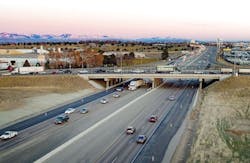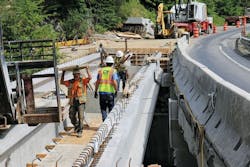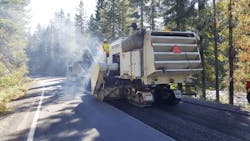Region Report: Idaho, Wyoming, and Montana
Nowhere is the extremity of our national geography more apparent than in the states that draw down from the Canadian border and through what was once, long ago, considered the western frontier of the nation.
It is there that great swathes of land roll forth, much even now sparsely peopled, yet couched within this terrain, like discreet instances of punctuation, cities and suburban landscapes are growing at a marvelous, somewhat surprising rate.
Case in point: Idaho.
Perhaps America’s most unassuming state, Idaho touches our neighbor to the north not far from Calgary and also shares its border with six other U.S. states. What does this mean for its transportation system? Lots of through traffic and lots of freight resulting from more than just the state’s evergreen agricultural industries, according to Idaho Transportation Department (ITD) Chief Engineer Blake Rindlisbacher.
“In the panhandle up north, we’ve got I-90 that cuts across the state from Washington to Montana,” Rindlisbacher told Roads & Bridges. “In the south, we’ve got I-84, which comes in at the Oregon border, crosses the state and goes south to Utah. Then there’s I-15 that comes up from Utah and into Montana. Those interstates carry a lot of truck traffic that isn’t even Idaho-based commerce; we’re a major pass-through state. And we’re primarily a rural state. Our population is only about 1.7 million. We’re also a pretty large state—a lot of land mass but with population centers that are spread out. We really rely on the interstate system and U.S. routes to connect our smaller rural communities together.”
Work on the Fish Creek bridge in north-central Idaho is representative of ITD’s focus on maintenance of a significant number of small bridges statewide.
Of that 1.7 million denizens, approximately 700,000 are located in the Treasure Valley region alone, which includes the Boise metropolitan area, the state’s largest concentration. When you consider that the remaining million is spread out over a further nearly 84,000 square miles, the acute challenge of keeping communities connected becomes readily apparent. And it is not just the sheer mileage that creates this challenge, it is what kind of land there is comprising it.
“There’s a sizable portion of Idaho that is mountainous, and there is limited access across these areas,” Rindlisbacher said. “Another one of the big challenges we have is that we have so much federal land. A lot of wilderness areas and a lot of Bureau of Lane Management land, and a lot of Forest Service land, which makes it difficult for us to fund our roads and bridges because we don’t have a whole lot of tax base.”
As any DOT or agency member knows, funding is a persistent need across the board, but ITD received, in 2015, a much needed infusion from its state legislature in the form of a gas-tax increase of 7 cents per gallon, the first increase of any kind in almost 20 years. The increase is estimated to bring $1.09 billion into the transportation budget over the next 10 years. Furthermore, in 2017 the legislature approved several non-gas tax revenue increases that amount to approximately $180 million of additional transportation funding over that same period. This increase in available funds has already allowed ITD to pursue several high-profile projects statewide, such as adding lanes and making key interchange modifications to the heavily traveled stretch of I-84 in the Nampa-to-Caldwell corridor, which has about a $350 million price tag. It has also allowed ITD to replace and modernize two system interchanges: the Wye Interchange (I-15/I-86) in east Idaho ($60 million) and the Salt Lake Interchange (I-84/I-86) in south-central Idaho ($30 million), which is the primary route of access to the Salt Lake region in Utah.
“60% of the gas tax dollars come to the state highway system and 40% goes to local jurisdictions,” ITD Public Information Specialist Reed Hollinshead told Roads & Bridges. “That itself is a challenge because we’ve got 288 local jurisdictions across the counties, so that 40% has a long way to stretch.”
Continued effective asset management is expected to help the department meet its other transportation needs arising from continued growth. Just under 91% of Idaho’s state highway system pavements (12,300 lane-miles statewide) are considered to be in good or fair condition. This additional transportation funding has allowed ITD to maintain 75% of the state’s 1,835 state highway system bridges in good condition and limit the poor condition bridges to only 2-3% (7% overall when local and county spans are counted).
Crews blade along the shoulder of a stretch of I-90 near Coeur d’Alene.
“Growth is maybe the biggest single factor affecting the department,” explained Rindlisbacher. “Idaho’s population is booming—for two years running, Idaho has been amongst states with the fastest growth rates—and with that comes increased demand on the transportation infrastructure. As traffic volumes increase, miles traveled increase. This results in additional demand for freight services, safety and capacity considerations, public transit, biking and walking, as well as operations, maintenance, and facilities funding.”
With the FAST Act headed to expiry in 2020, Idaho is engaged in transportation funding alternatives. Over the past year, Idaho participated in a Washington State Transportation Commission pilot program to test a pay-per-mile tax system. Motorists experienced road-usage charging and provided feedback. A final report and analysis is expected in early 2020.
“Idaho will continue to have needs,” Rindlisbacher continued. “Idaho’s legislature is aware of the growth-related challenges and has thankfully helped reduce the funding gap. However, there’s simply not enough money available to meet all the needs.”
Nonetheless, the future, like the northwestern Idaho sky, is bright. “We’re making the right investments in our roads and bridges,” Rindlisbacher concluded.
This work on a narrow and windy stretch of two-lane road is typical of many rural areas in Idaho.
THE EQUALITY STATE
If Idaho is challenged with connecting disparate communities, then Wyoming doubles down in that regard. The state is the 10th largest by area, as well as the least populous, and the second most sparsely populated state in the country. While less of a throughway state than others surrounding it, due in good part to the orientation of its major highways and the bulk of its northwest corner being occupied by Yellowstone National Park, Shoshone National Forest, and the Wind River Reservation, the state is nonetheless facing challenges similar to its more mountainous brethern.
According to the most recent FHWA statistics, the state’s bridge inventory holds approximately 8% of structures classified as being in “poor” condition, and a near-identical percentage of “poor” state-owned roads. While these percentages are practically reasonable against national averages, Wyoming, like Idaho, suffers from a struggling tax base. In response to this challenge, the state legislature cleared a 10 cent per gallon gas tax boost that began drawing results in 2013, in consequence of which the Wyoming DOT has been able to make progress in project planning and letting. According to WyDOT numbers, over 75 overlay, rehab, and widening projects have been completed since 2013, with another half dozen on the let. Moving into 2020, reconstruction is expected on U.S. 20, and rehabilitation will take place on another 130+ miles of state roadway. Moreover, a Statewide Transportation Improvement Program is expected to further ramp up project planning—which is quite needed as vehicle travel on Wyoming roads has gone up 21% in this young century alone.
Crews will be tackling a series of projects on I-84 in the Nampa-to-Caldwell corridor, part of a $350 million total investment in expansion in the growing area.
NORTHERNMOST
Montana’s roads and bridges are funded mainly through a combination of federal (88.5%) and state/locally derived (11.5%) sources. The state general revenue fund gives nothing to the Montana DOT, thus the agency finds itself strapped into a pattern difficult to redirect. In 2017, the Bridge and Road Safety and Accountability Act was passed, increasing the state’s fuel tax to $0.315 per gallon for gas and $0.2925 for special fuels. 35% of the dollars realized from the measure have aided the DOT (the remaining 65% go to local governments).
This modest influx is most welcome in light of the fact that 29% of state roads are either poor or mediocre, and the state’s road fatality rate (1.47 deaths per 100 million miles traveled; 2.05 rural) is far in excess of the national average (1.16; 0.93 rural). Still, the state is all in on Vision Zero planning, and lives saved are worth every effort required to save them.




